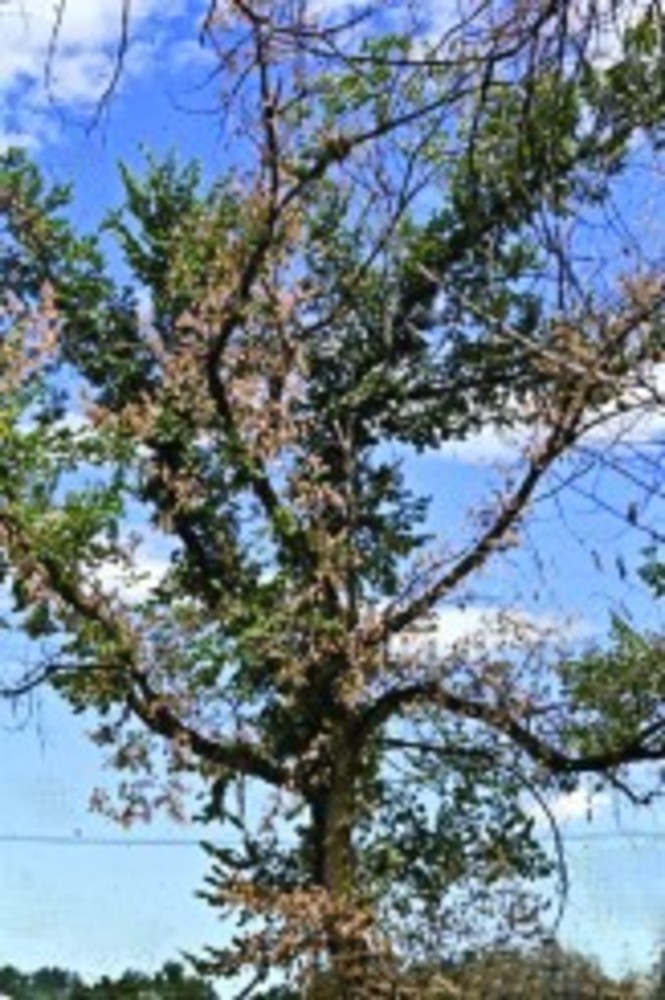History of Dutch elm disease

Dutch elm disease (DED) is a vascular wilt disease caused by the fungus Ophiostoma
novo-ulmi that affects American elms by killing individual branches and ultimately causing the tree’s death in one to several years. This fungus is spread by the native elm bark beetle (Hylurgopinus rufipe), which is the disease’s major vector (carrier), as it travels from elm to elm feeding on twigs or through root grafts of neighboring diseased elm trees. Symptoms of DED begin as wilting yellow and brown leaves within the elm’s crown and proceed to develop down the tree. These symptoms may also begin at the bottom of the tree or rapidly overtake the entire structure if DED is introduced through grafted roots.
At one time, this urban shade tree could be found in prolific numbers alongside the streets and roadways of numerous American cities and suburbs. With large vase-like branches reaching heights of 80 feet shading both street and yard, these trees were champions of grace and beauty. The American elm, as it was known, is all but a memory in today’s landscape.
Dutch elm disease gains its name from the Dutch phytopathologists Bea Schwarz and Christine Buisman, who first discovered the disease in the 1920s. But Dutch elm disease is not to be blamed on the Dutch for its introduction to America; rather it was an introduced pathogen from Asia.
The death of the American elm is a tragic loss for our landscape, but it is also a teaching moment that has transformed the preventative measures communities, planners and designers can take when planting landscapes.
When elm trees were planted as a monoculture (singular species planting) down city streets, the elm bark beetle had great opportunity to feed and spread disease in the process. The destruction of these trees left streets bare with treeless sidewalks and a vastly altered landscape in need of replanting.
Today, we have learned from these practices, and street tree plantings have become diversified. By varying street tree plantings with an assortment of species along our streets, planners have developed a tool to try combating the spread of disease and limit the impact on a landscape if a particular species needs to be removed due to declining health or death. You see, many diseases that affect trees are species-specific; for example, certain pathogens that attack elms will not attack maples. With a diversified landscape, the removal of two or three trees along a city block may not be as severe as the removal of all the trees as was the case in many areas due to the exclusive planting of elms in some neighborhoods.
On the bright side, there are still some living American elms, and these stalwarts have seemingly survived the era of mass death between the 1950s and 1980s by winning the veritable genetic lottery. Those left standing today are reminders of the past and the magnificence these trees once showcased. These remaining trees must also be coddled. Through the years, scientists have developed methods to save any remaining American elm trees unaffected by DED; one of these is through fungicidal injections into the tree’s root flare. These precautions have proven successful but are costly and may be out of the realm of most homeowners’ expertise and budgets.
With only a few American elms alive in Rhode Island, it is sad when any must be removed due to death or disease.
Last month, the Rhode Island Historical Society earmarked an American elm to be removed from the grounds of the historic John Brown House Museum. (See the companion article on page 29.) This will be the second American elm in under a year that the Historical Society will have removed due to declining health. While this tree posed a safety hazard, it has tested negative for Dutch elm disease, but it will be taken down for other health issues.
There has been much research done, as you can expect, on finding viable alternative elm tree cultivars that are DED-resistant. Two such cultivars are Valley Forge and New Harmony, both grown out of the U.S. National Arboretum tree genetics program, which boasts more than 60 years of research, three generations of scientists and testing on more than 60,000 elm trees. These cultivars, and others, are now available to nurseries and garden centers with the hope that one day the American elm can regain the prominent stature it once held in our landscapes.
TEE JAY BOUDREAU is the Urban and Community Forestry Program Coordinator for the R.I. Depart-ment of Environmental Management. For urban forestry-related questions, contact him at 401-222-2445, ext. 2059.







